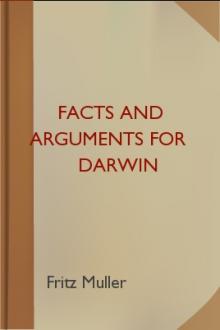The Expression of Emotion in Man and Animals by Charles Darwin (adult books to read TXT) 📕

- Author: Charles Darwin
- Performer: -
Book online «The Expression of Emotion in Man and Animals by Charles Darwin (adult books to read TXT) 📕». Author Charles Darwin
When the Mandrill is in any way excited, the brilliantly coloured, naked parts of the skin are said to become still more vividly coloured.
With several species of baboons the ridge of the forehead projects much over the eyes, and is studded with a few long hairs, representing our eyebrows. These animals are always looking about them, and in order to look upwards they raise their eyebrows.
They have thus, as it would appear, acquired the habit of frequently moving their eyebrows. However this may be, many kinds of monkeys, especially the baboons, when angered or in any way excited, rapidly and incessantly move their eyebrows up and down, as well as the hairy skin of their foreheads.[15] As we associate in the case of man the raising and lowering of the eyebrows with definite states of the mind, the almost incessant movement of the eyebrows by monkeys gives them a senseless expression.
I once observed a man who had a trick of continually raising his eyebrows without any corresponding emotion, and this gave to him a foolish appearance; so it is with some persons who keep the corners of their mouths a little drawn backwards and upwards, as if by an incipient smile, though at the time they are not amused or pleased.
[14] Brehm, `Thierleben,’ B. i. s. 84. On baboons striking the ground, s. 61.
A young orang, made jealous by her keeper attending to another monkey, slightly uncovered her teeth, and, uttering a peevish noise like tish-shist, turned her back on him. Both orangs and chimpanzees, when a little more angered, protrude their lips greatly, and make a harsh barking noise.
A young female chimpanzee, in a violent passion, presented a curious resemblance to a child in the same state. She screamed loudly with widely open mouth, the lips being retracted so that the teeth were fully exposed.
She threw her arms wildly about, sometimes clasping them over her head.
She rolled on the ground, sometimes on her back, sometimes on her belly, and bit everything within reach. A young gibbon (_Hylobates syndactylus_) in a passion has been described[16] as behaving in almost exactly the same manner.
The lips of young orangs and chimpanzees are protruded, sometimes to a wonderful degree, under various circumstances.
They act thus, not only when slightly angered, sulky, or disappointed, but when alarmed at anything—in one instance, at the sight of a turtle,[17]—and likewise when pleased.
But neither the degree of protrusion nor the shape of the mouth is exactly the same, as I believe, in all cases; and the sounds which are then uttered are different.
The accompanying drawing represents a chimpanzee made sulky by an orange having been offered him, and then taken away.
A similar protrusion or pouting of the lips, though to a much slighter degree, may be seen in sulky children.
[15] Brehm remarks (`Thierleben,’ s. 68) that the eyebrows of the Inuus ecaudatus are frequently moved up and down when the animal is angered.
[16] G. Bennett, `Wanderings in New South Wales,’ &c. vol.
ii. 1834, p. 153. FIG. 18.-Chimpanzee disappointed and sulky.
Drawn from life by Mr. Wood.
Many years ago, in the Zoological Gardens, I placed a looking-glass on the floor before two young orangs, who, as far as it was known, had never before seen one. At first they gazed at their own images with the most steady surprise, and often changed their point of view.
They then approached close and protruded their lips towards the image, as if to kiss it, in exactly the same manner as they had previously done towards each other, when first placed, a few days before, in the same room.
They next made all sorts of grimaces, and put themselves in various attitudes before the mirror; they pressed and rubbed the surface; they placed their hands at different distances behind it; looked behind it; and finally seemed almost frightened, started a little, became cross, and refused to look any longer.
When we try to perform some little action which is difficult and requires precision, for instance, to thread a needle, we generally close our lips firmly, for the sake, I presume, of not disturbing our movements by breathing; and I noticed the same action in a young Orang. The poor little creature was sick, and was amusing itself by trying to kill the flies on the window-panes with its knuckles; this was difficult as the flies buzzed about, and at each attempt the lips were firmly compressed, and at the same time slightly protruded.
[17] W. L. Martin, Nat. Hist. of Mamm. Animals, 1841, p. 405.
Although the countenances, and more especially the gestures, of orangs and chimpanzees are in some respects highly expressive, I doubt whether on the whole they are so expressive as those of some other kinds of monkeys.
This may be attributed in part to their ears being immovable, and in part to the nakedness of their eyebrows, of which the movements are thus rendered less conspicuous. When, however, they raise their eyebrows their foreheads become, as with us, transversely wrinkled.
In comparison with man, their faces are inexpressive, chiefly owing to their not frowning under any emotion of the mind—that is, as far as I have been able to observe, and I carefully attended to this point.
Frowning, which is one of the most important of all the expressions in man, is due to the contraction of the corrugators by which the eyebrows are lowered and brought together, so that vertical furrows are formed on the forehead.
Both the orang and chimpanzee are said[18] to possess this muscle, but it seems rarely brought into action, at least in a conspicuous manner.
I made my hands into a sort of cage, and placing some tempting fruit within, allowed both a young orang and chimpanzee to try their utmost to get it out; but although they grew rather cross, they showed not a trace of a frown.
Nor was there any frown when they were enraged. Twice I took two chimpanzees from their rather dark room suddenly into bright sunshine, which would certainly have caused us to frown; they blinked and winked their eyes, but only once did I see a very slight frown. On another occasion, I tickled the nose of a chimpanzee with a straw, and as it crumpled up its face, slight vertical furrows appeared between the eyebrows.
I have never seen a frown on the forehead of the orang.
[18] Prof. Owen on the Orang, Proc. Zool. Soc. 1830, p. 28.
On the Chimpanzee, see Prof. Macalister, in Annals and Mag.
of Nat. Hist. vol. vii. 1871, p. 342, who states that the corrugator supercilii is inseparable from the orbicularis palpebrarum.
The gorilla, when enraged, is described as erecting its crest of hair, throwing down its under lip, dilating its nostrils, and uttering terrific yells. Messrs. Savage and Wyman[19]
state that the scalp can be freely moved backwards and forwards, and that when the animal is excited it is strongly contracted; but I presume that they mean by this latter expression that the scalp is lowered; for they likewise speak of the young chimpanzee, when crying out, as having the eyebrows strongly contracted.”
The great power of movement in the scalp of the gorilla, of many baboons and other monkeys, deserves notice in relation to the power possessed by some few men, either through reversion or persistence, of voluntarily moving their scalps.[20]
Astonishment, Terror—A living fresh-water turtle was placed at my request in the same compartment in the Zoological Gardens with many monkeys; and they showed unbounded astonishment, as well as some fear.
This was displayed by their remaining motionless, staring intently with widely opened eyes, their eyebrows being often moved up and down.
Their faces seemed somewhat lengthened. They occasionally raised themselves on their hind-legs to get abetter view. They often retreated a few feet, and then turning their heads over one shoulder, again stared intently.
It was curious to observe how much less afraid they were of the turtle than of a living snake which I had formerly placed in their compartment;[21]
for in the course of a few minutes some of the monkeys ventured to approach and touch the turtle. On the other hand, some of the larger baboons were greatly terrified, and grinned as if on the point of screaming out.
When I showed a little dressed-up doll to the Cynopithecus niger, it stood motionless, stared intently with widely opened eyes, and advanced its ears a little forwards. But when the turtle was placed in its compartment, this monkey also moved its lips in an odd, rapid, jabbering manner, which the keeper declared was meant to conciliate or please the turtle.
[19] Boston Journal of Nat. Hist. 1845–47, vol. v. p. 423. On the Chimpanzee, ibid. 1843-44, vol. iv. p. 365.
[20] See on this subject, `Descent of Man,’ vol. i. p. 20.
I was never able clearly to perceive that the eyebrows of astonished monkeys were kept permanently raised, though they were frequently moved up and down. Attention, which precedes astonishment, is expressed by man by a slight raising of the eyebrows; and Dr. Duchenne informs me that when he gave to the monkey formerly mentioned some quite new article of food, it elevated its eyebrows a little, thus assuming an appearance of close attention.
It then took the food in its fingers, and, with lowered or rectilinear eyebrows, scratched, smelt, and examined it,—
an expression of reflection being thus exhibited. Sometimes it would throw back its head a little, and again with suddenly raised eyebrows re-examine and finally taste the food.
In no case did any monkey keep its mouth open when it was astonished.
Mr. Sutton observed for me a young orang and chimpanzee during a considerable length of time; and however much they were astonished, or whilst listening intently to some strange sound, they did not keep their mouths open.
This fact is surprising, as with mankind hardly any expression is more general than a widely open mouth under the sense of astonishment.
As far as I have been able to observe, monkeys breathe more freely through their nostrils than men do; and this may account for their not opening their mouths when they are astonished; for, as we shall see in a future chapter, man apparently acts in this manner when startled, at first for the sake of quickly drawing a full inspiration, and afterwards for the sake of breathing as quietly as possible.
[21] `Descent of Man,’ vol, i. p, 43.
Terror is expressed by many kinds of monkeys by the utterance of shrill screams; the lips being drawn back, so that the teeth are exposed.
The hair becomes erect, especially when some anger is likewise felt.
Mr. Sutton has distinctly seen the face of the Macacus rhesus
grow pale from fear. Monkeys also tremble from fear; and sometimes they void their excretions. I have seen one which, when caught, almost fainted from an excess of terror.
Sufficient facts have now been given with respect to the expressions of various animals. It is impossible to agree with Sir C. Bell when he says[22]
that “the faces of animals seem chiefly capable of expressing rage and fear;”
and again, when he says that all their expressions “may be referred, more or less plainly, to their acts of volition or necessary instincts.”
He who will look at a dog preparing to attack another dog or a man, and at the same animal when caressing his master, or will watch the countenance of a monkey when insulted, and when fondled by his keeper, will be forced to admit that the movements of





Comments (0)